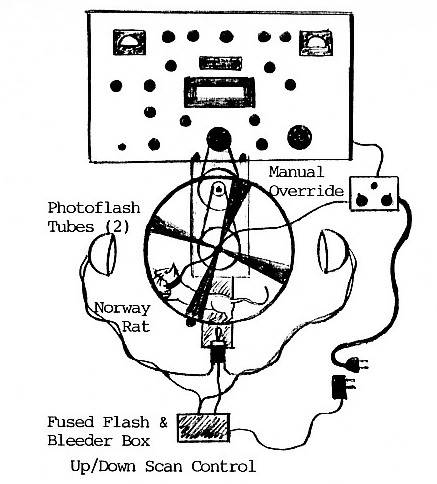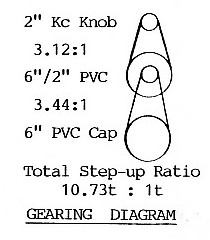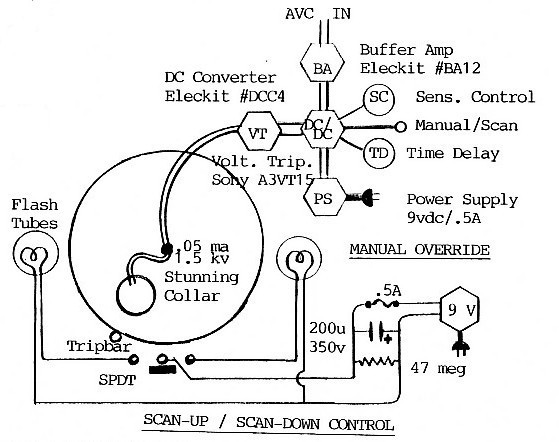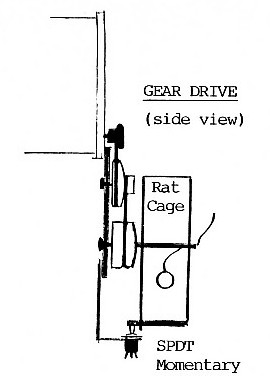A BLANDX ClassicSCANDINAVIAN SCAN CONVERSION
|
This article originally appeared in the September 1991 edition of BLANDX.
The Scandinavian Scan Conversion (SSC) was invented by former German SS veternary experimenter Gerhardt Katt. Herr Katt, following his parole from Ft. Leavenworth federal prison for war crimes and his crimes against nature, defected to East Berlin in 1955. He was then inducted into the army of the DDR, and was stationed with the scientific experimentation unit in Dresden. Shortly thereafter, a large shipping crate arrived from Berlin. The contents of the box included 1) R-390A (Motorola) in original crate and a full set of operational and field maintainence manuals. Apparently, this prize had been acquired through the feminine wiles of a winsome E. German spy.
 Throughout 1962, different modifications and improvements were attempted. The most sucessful of these experiments was the SSC. As a matter of fact, Herr Katt was awarded both the Order of Lenin and the Aluminum Cross. His experiments had proven a reliable method of scanning could be accomplished by the use of Norway rats in an exercise cage. The rats had a 5 millisecond response time, only a 2 degree backlash figure, and the most important quality of longevity ... they outlived all other small animals by a factor of greater than 10:1. Their useful lifetime was calculated to be, on the average, three months and eight days.
Throughout 1962, different modifications and improvements were attempted. The most sucessful of these experiments was the SSC. As a matter of fact, Herr Katt was awarded both the Order of Lenin and the Aluminum Cross. His experiments had proven a reliable method of scanning could be accomplished by the use of Norway rats in an exercise cage. The rats had a 5 millisecond response time, only a 2 degree backlash figure, and the most important quality of longevity ... they outlived all other small animals by a factor of greater than 10:1. Their useful lifetime was calculated to be, on the average, three months and eight days.
Only three minor design changes were instituted between 1962 and 1975. These changes were instituted in order to fine tune the manual override control. Field Change #1 consisted of installing a 1 kohm / 1 W resistor in the output of the 1.5 kv voltage tripler. In so doing, it was found that rat life was increased to slightly over five months with only a consequent loss of 1 m/sec in response. F.C. #2 was instituted to reduce power consumption and involved the substitution of a solid state power supply for both the Override and Up/Down controls. The third change completed the solid state conversion by replacing the buffer amplifier, converter, and tripler.
 The operation of the SSC is really rather simple. Scanning is begun by flicking the momentary switch below the cage. This discharges the photoflash condenser through either the
The operation of the SSC is really rather simple. Scanning is begun by flicking the momentary switch below the cage. This discharges the photoflash condenser through either the up
or down
flash tube. The rat panics, turns, and runs. The gear reduction system properly conveys one complete rotation of the cage into exactly 10 3/4 turns of the kilocycle knob, which covers not only the complete megacycle band, but the overtravel zones both above and below. Upon the completion of one rotation, which requires only 5.6 sec (avg.), the tripbar strikes the momentary switch and trips the other flash tube, which, of course, sends the rat scurrying back from wence he came. A warning should be mentioned here: care must be taken not to choose a band for which propagation is poor or unuseable as this will greatly shorten rat life.
 Lock-up is accomplished through the use of the Manual Override Unit. This is the heart of the SSC. AVC voltage from the 3rd IF output is delivered to the buffer amplifier. Buffer output is then sent to the DC to DC converter, where it is rectified and used to control a stunning charge which is fed to the rat collar through a voltage tripler. The time delay control regulates the charge to be delivered and, thus, the length of unconsciousness of the rat. The sensitivity control sets a threshold level for the automatic actuation of the unit. And, finally, there is the manual override button which discharges the unit when depressed.
Lock-up is accomplished through the use of the Manual Override Unit. This is the heart of the SSC. AVC voltage from the 3rd IF output is delivered to the buffer amplifier. Buffer output is then sent to the DC to DC converter, where it is rectified and used to control a stunning charge which is fed to the rat collar through a voltage tripler. The time delay control regulates the charge to be delivered and, thus, the length of unconsciousness of the rat. The sensitivity control sets a threshold level for the automatic actuation of the unit. And, finally, there is the manual override button which discharges the unit when depressed.
 Sensitivity is as low as 5 uv. The time delay is variable from 5 sec. to greater than 30 sec. WARNING: Setting the delay for lengthier times may seriously shorten the lifetime of the unit, and may occasion the failure of certain integral parts.
Installation of the unit is accomplished by drilling two 10/32 holes and tapping accordingly. The black phenolic mounting panel is then mounted to the bottom of the R-390A front panel. The dial cords are strung and appropriate electrical connections are made. And, now you are ready to scan.
Sensitivity is as low as 5 uv. The time delay is variable from 5 sec. to greater than 30 sec. WARNING: Setting the delay for lengthier times may seriously shorten the lifetime of the unit, and may occasion the failure of certain integral parts.
Installation of the unit is accomplished by drilling two 10/32 holes and tapping accordingly. The black phenolic mounting panel is then mounted to the bottom of the R-390A front panel. The dial cords are strung and appropriate electrical connections are made. And, now you are ready to scan.
All parts are available in kit form from Gestapo Electronics in Salem, Oregon. The cost is 955 Deutsche marks or $174.99 (U.S.) plus shipping. All credit cards accepted. Installation time is approximately two hours. Rats must be acquired locally. Full warranty is backed by Kattkits, AEG 7 Ottostrasse, Leipzig, Germany.
No electric drill overtravel. No time consuming drill connect and disconnect. Full AVC control. A superior product.





